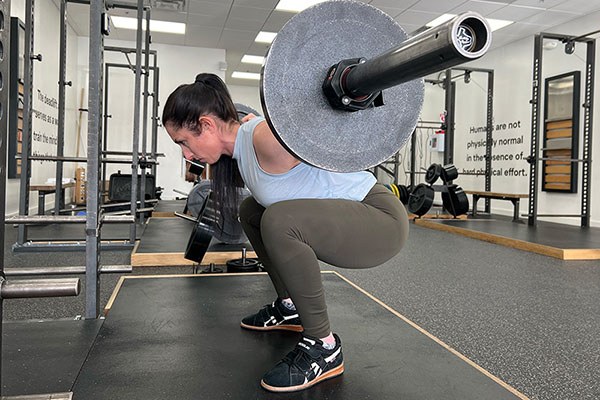
[adinserter block=”2″]
Cueing Shoulders Over the Bar
by stef bradford, PhD, SSC | December 20, 2023
The beauty of using the basic barbell lifts to get strong is that all
of them demand the dynamic involvement and coordination of the entire
body. The means the system is trained as whole, as nerve activates
muscle to move bones to operate joints against the stable positions
held by other muscles and bones as we balance the load through the
lift. This integration allows effective and efficient strengthening of movement patterns when programmed progressively, while at the same
time developing the ability to perform each one efficiently.
Since we are learning
whole-body movement skills under the bar during this process, it
isn’t surprising that they carry over from one lift to another, along
with improvements in strength. Many lifters have noticed that
practice from setting the back into extension at the start of each
deadlift makes it easier to set and hold the back in the squat.
Similarly, each setup for the bench press where the chest is lifted
and scapulas pinned together carries over into the ability to assume
and hold the upper back position needed in the squat. Or the other
way around. Or both. The lifts reinforce each other.
Mental images of lifts
that drive cues can also be productive when they cross from one
movement to another. One I have recently have found good success
borrowing from the clean for the deadlift is “shoulders over the
bar.”
The deadlift and clean
appear very similar at the outset, differing in grip width and
sometimes minor adjustments in stance, but both use the first four steps of the deadlift setup – stance, grip, shins, chest up – to
properly get into the start position. After that,
the lifts rapidly diverge. The mechanical differences in grinding a
deadlift to lockout versus launching a clean to the shoulders begin
immediately with the push off the floor. In the deadlift, the back
angle becomes more vertical as the bar leaves the floor to reduce the
moment arm on the back segment and allow a heavier weight to be
moved. In contrast, the clean preserves the more-horizontal back angle so that a longer moment arm can be used to accelerate a lighter
load.
“Shoulders over the bar”
cues the lifter to intentionally keep the back angle more horizontal
with higher hips during the early part of the clean. In this
position, the bar is more efficiently accelerated from the floor with
a longer moment arm between hips and bar, generating more momentum
and carrying the bar faster and higher to the shoulders. So the cue
works by triggering the different movement pattern used for the clean
to get the best display of power out of the lifter.
While the squat and clean
look very different from each other, they share an important demand:
a more horizontal back position is critical for producing the best
outcome. Anything that prevents the lifter from getting or keeping
the back angle sufficiently horizontal during the squat will reduce
hip drive, which means less muscle mass in the movement, less weight
on the bar, and therefore less stress to drive adaptation. An
all-around fail, but a very common error.
In both the squat and the
clean, the lifter has to fight a tendency to get vertical at the
wrong time in order to get the most out of the lift. The bar is
obviously on top of the back in the squat and hanging under the back
in the clean, but the idea of keeping the shoulders forward relative
to the bar holds, at least for those who understand the mechanics of
the two lifts. The experience of pulling the bar teaches these
mechanics, if you pay attention. The cues might be “shoulders over
the knees” or simply “shoulders over.”
Cueing this idea during
the descent of a squat works to emphasize reaching forward with the
shoulders as the hips reach back, reinforcing both bending over and
back extension at the same time. “Shoulders over” while
approaching the bottom helps keep this position tight and in place
during the critical bounce up out of the hole. Focusing on “shoulders
over” as the ascent continues can help keep the chest from being
lifted early, allowing the lifter to stay in the hips and maintain
bar speed.
If you’re having trouble getting or keeping
your back in position in the squat, try this cue borrowed from the
clean. It may work where the other cues for this same problem have
not. And when you train, pay attention to what each lift can teach
you about the others.
[adinserter block=”2″]
Credit : Source Post






